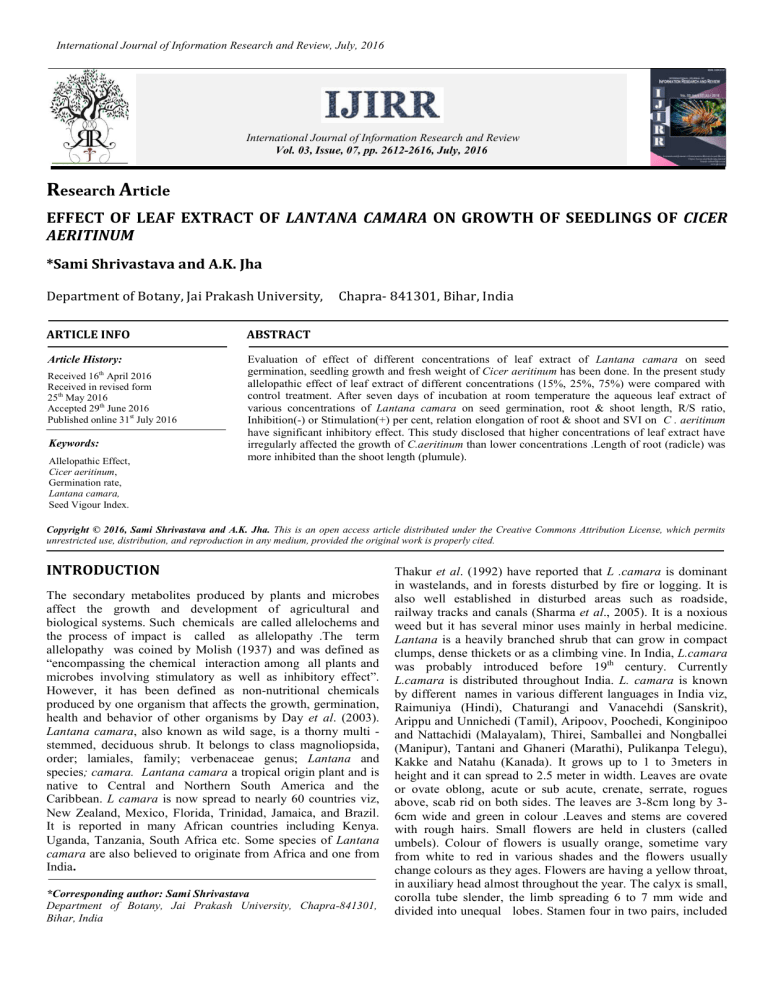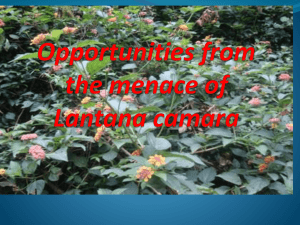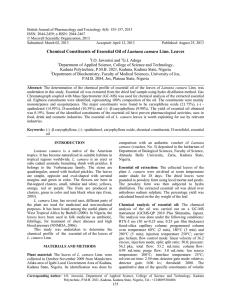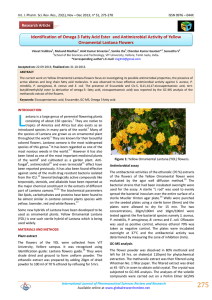PDF File - International Journal of Information Research and Review

International Journal of Information Research and Review, July, 2016
International Journal of Information Research and Review
Vol. 03, Issue, 07, pp. 2612-2616, July, 2016
R
esearch
A
rticle
EFFECT OF LEAF EXTRACT OF LANTANA CAMARA ON GROWTH OF SEEDLINGS OF CICER
AERITINUM
*Sami Shrivastava and A.K. Jha
Department of Botany, Jai Prakash University, Chapra- 841301, Bihar, India
ARTICLE INFO ABSTRACT
Article History:
Received 16 th
April 2016
Received in revised form
25 th
May 2016
Accepted 29 th
June 2016
Published online 31 st
July 2016
Keywords:
Evaluation of effect of different concentrations of leaf extract of Lantana camara on seed germination, seedling growth and fresh weight of Cicer aeritinum has been done. In the present study allelopathic effect of leaf extract of different concentrations (15%, 25%, 75%) were compared with control treatment. After seven days of incubation at room temperature the aqueous leaf extract of various concentrations of Lantana camara on seed germination, root & shoot length, R/S ratio,
Inhibition(-) or Stimulation(+) per cent, relation elongation of root & shoot and SVI on C . aeritinum have significant inhibitory effect. This study disclosed that higher concentrations of leaf extract have irregularly affected the growth of C.aeritinum than lower concentrations .Length of root (radicle) was
Allelopathic Effect,
Cicer aeritinum ,
Germination rate,
Lantana camara,
Seed Vigour Index. more inhibited than the shoot length (plumule).
Copyright © 2016, Sami Shrivastava and A.K. Jha.
This is an open access article distributed under the Creative Commons Attribution License, which permits unrestricted use, distribution, and reproduction in any medium, provided the original work is properly cited.
INTRODUCTION
Thakur et al . (1992) have reported that L .camara is dominant
The secondary metabolites produced by plants and microbes affect the growth and development of agricultural and
Department of Botany, Jai Prakash University, Chapra-841301, also well established in disturbed areas such as roadside, railway tracks and canals (Sharma et al ., 2005). It is a noxious biological systems. Such chemicals are called allelochems and the process of impact is called as allelopathy .The term
*Corresponding author: Sami Shrivastava weed but it has several minor uses mainly in herbal medicine.
Lantana is a heavily branched shrub that can grow in compact allelopathy was coined by Molish (1937) and was defined as
“encompassing the chemical interaction among all plants and clumps, dense thickets or as a climbing vine. In India, L.camara
was probably introduced before 19 th
century. Currently microbes involving stimulatory as well as inhibitory effect”.
However, it has been defined as non-nutritional chemicals
India .
L.camara
is distributed throughout India. L. camara is known by different names in various different languages in India viz, produced by one organism that affects the growth, germination, health and behavior of other organisms by Day et al . (2003). camara are also believed to originate from Africa and one from
Raimuniya (Hindi), Chaturangi and Vanacehdi (Sanskrit),
Arippu and Unnichedi (Tamil), Aripoov, Poochedi, Konginipoo
Lantana camara , also known as wild sage, is a thorny multi stemmed, deciduous shrub. It belongs to class magnoliopsida,
Uganda, Tanzania, South Africa etc. Some species of Lantana and Nattachidi (Malayalam), Thirei, Samballei and Nongballei
(Manipur), Tantani and Ghaneri (Marathi), Pulikanpa Telegu), order; lamiales, family; verbenaceae genus; species ; camara.
Lantana camara
Lantana and
a tropical origin plant and is
It is reported in many African countries including Kenya.
Kakke and Natahu (Kanada). It grows up to 1 to 3meters in height and it can spread to 2.5 meter in width. Leaves are ovate native to Central and Northern South America and the
Caribbean.
L camara is now spread to nearly 60 countries viz, or ovate oblong, acute or sub acute, crenate, serrate, rogues above, scab rid on both sides. The leaves are 3-8cm long by 3-
6cm wide and green in colour .Leaves and stems are covered with rough hairs. Small flowers are held in clusters (called umbels). Colour of flowers is usually orange, sometime vary from white to red in various shades and the flowers usually change colours as they ages. Flowers are having a yellow throat, in auxiliary head almost throughout the year. The calyx is small, corolla tube slender, the limb spreading 6 to 7 mm wide and divided into unequal lobes. Stamen four in two pairs, included
Bihar, India in wastelands, and in forests disturbed by fire or logging. It is
2613 Sami Shrivastava and A.K. Jha.
Effect of leaf extract of lantana camara on growth of seedlings of cicer aeritinum and ovary two celled, two ovuled. Inflorescences are produced in pairs in the axils of opposite leaves. Inflorescences are compact, dome shaped 2-3 cm across and contain 20-40 sessile flowers. Root system is very strong and it gives out new fresh shoots even after repeated cuttings. Lantana camar a has many negative impacts including potential to disrupt succession cycle, displacing native biota resulting in decreased biodiversity
(Ghisalberti, 2000; Day et al ., 2003). Understorey competitor for forestry (Sharma et al ., 2005), reduce the economic viability of the crops (Day et al ., 2003 and Sharma et al ., 2005), allelopathic qualities reduces the vigor of native plant species and limits their productivity and interferes with harvesting
(Sharma et al ., 1988; Sharma and Sharma,1989 and Sharma et al ., 2005), poisoning of livestock by plants (Pass and
Heath,1978; Sharma et al ., 1999;and Sharma et al ., 2007) and seeds are poisonous if ingested.
The different parts of Lantana camara contain allelochemicals mainly aromatic alkaloids and phenolic compounds (Ambika et al ., 2003) which can interfere with seed germination and early growth of many plant species (Sohid and Sugau, 1993, Gentle and Duggin 1977, Sharma et al ., 2005, Ahmad et al ., 2007).
Lantana can also interfere with the growth of nearby plants by outcompeting for soil nutrients (Dubhal et al ., 2010) and altering microenvironment (e.g. light, temperature) by forming dense thickets (Sharma and Raghubanshi, 2007). The studies have demonstrated that extracts from the leaves can be employed to combat antimicrobial, fungicidal, insecticidal and nematicidal problems. Its potential to serve as biocide has also been described by several scientists (Begum et al ., 2004;
Dharagadda et al , 2005). Many Lantana varieties are poisonous to stock. It is difficult to know which varieties are toxic so it is better to treat all forms as potentially poisonous. The toxins in lantana include the triterpene acids lantadene A (rehmanic acid), lantadene B, and their reduced forms. Most cases of
Lantana poisoning occur when new stocks are introduced into lantana infested areas. Stock bred on Lantana infested country avoid lantana unless forced to eat it due to lack of other fodder.
Young animals introduced to lantana areas are most at risk. The present study was conducted to evaluate the effect of leaf extracts of Lantana camara on root and shoot growth of Cicer aeritinum . in the petridishes when moisture content of the filter paper declined. After one week number of germinated seeds were counted and the root (radical) and shoot (plumule) length were measured. Root: shoot ratio was calculated by dividing the values root by shoot.
The relation elongation ratio of root and shoot were calculated following the formula:
The values for calculation of inhibition (-) or stimulation (+) per cent were calculated following the formula given below:
RESULTS
Seed Germination
The rate of seed germination (%) was recorded after seven days of setting up of the experiment. Sharp differences in the rate of seed germination was not observed in different concentrations of leaves extract compared to control condition. The per cent seed germination was 100% in control condition and 90 to 100
% in different concentrations of leaf extract of Lantana camara. The minimum rate of seed germination was observed in 25% leaf extract of L. camara (Fig 1).
NO inhibition in seed germination was observed in 15% treatment however seed germination was inhabited -6.66% in 75% treatment and -10% in 25% treatment (Table 1).
MATERIAL AND METHODS
The leaves of Lantana camara were collected from J.P.
University, Chapra, campus in the month of January 2016, and were air dried in shade for 3-4 days The dried leaves were grinded to powder using laboratory blender . 10 grams of leaves powder where mixed with 100ml distilled water and were left for 24h at the room temperature and then filtered. Aqueous
Fig.1. Seed germination of L. camara.
Root and shoot length extract thus obtained were filtered through plastic kip with whatman filter paper. The extract was kept in a beaker for
The length of root and shoot was measured after seven days of further use .The filtrate was taken to study the effect of leaf seed germination. (Table 1, Fig. 2). The length of root varied from 2.04 cm to 2.56cm in different concentrations of leaf extracts on seedling growth of Cicer aeriternum . In this experiment 120 seeds were soaked for 24h in leaf extract.
Three replicates were maintained for each treatment. One treatment was run as control with distilled water only and three extract of Lantana camara whereas this value was 4.12cm for control condition. The maximum value 2.56 cm was recorded for 75% and minimum value 2.04 cm for 25 %.The length of shoot value varied from 2.11 to 3.50cm in different concentrations (15%, 25%, 75%) of the leaf extract were used to check the allelopathic effect of Lantana camara . Ten seeds were placed in each petridishes with moistened filter paper. All concentrations of leaf extract of Lantana camara where as this value was 3.51 cm for control treatment. The minimum value the petridishes were maintained under laboratory conditions
(room temperature). Equal volume of distilled water was added
15% treatment.
2614 International Journal of Information Research and Review Vol. 03, Issue, 07, pp. 2612-2616, July, 2016
(Table, 2). Inhibition in rate of seed germination ranged from -
6.66% and -10% in case of 25% and 75% treatments, respectively (Table1, Fig. 4).
Fig. 2. Root & Shoot length (cm) of L.camara
Root: Shoot Ratios
The root: shoot ratios were calculated in different treatments of leaf extract of L.camara
. This value in control condition was
1.17. The minimum value 0.71 was recorded for 15% and maximum value was 1.11 for 75% concentration (Table 1, Fig.
3). The relation elongation ratios of root and shoot were recorded in different concentrations of leaf extract of L. camara . These values were compared to control condition
(Table 2).
Fig.4. Inhibition (-) or Stimulation (+) %
Relation elongation ratio of root and shoot
The minimum value for root elongation ratio was 49.5% recorded for 25% and maximum value 62.13% for 75% concentrations of leaf extract (Table 2, Fig. 5).
Fig.5. Relation elongation ratio of root (%)
Fig.3 Root: Shoot Ratios of L.camara
1
2
3
4
Control
15%
25%
75%
Table 1. Impact of leaf extract of L. camara on seed germination,
Root length, shoot length, R:S ratio and inhibition (-) or stimulation (+)
S.No Treatment Germination
( %) on Cicer aeritinum.
100%
100%
90%
93.33%
Germination Inhibition /Stimulation (%)
Radicle Length
(cm)
4.12
± 2.40
2.50
± 0.67
2.04
±0.33
2.56
± 0.49
The minimum value for shoot elongation ratio was 60.11% recorded for 25% and maximum value 99.71 % for 15% concentration of leaf extract (Fig,6).
Plumule Length
(cm)
3.51
± 04
3.50
± 0.40
2.11
±0.31
2.15
± 0.37
R/S
Ratio
Inhibition (-) or Stimulation(+)
(%)
1.17 _______
0.71 00
0.96 -10%
1.11 -6.66%
Seed Vigour Index (SVI)
In this study no stimulatory only inhibitory effect on seed germination of C. aertinum was observed which was calculated by using the formula proposed by Sahid and Sugau (1993)
The minimum value for SVI was 185.71 recorded for 25% and maximum value 355.12% for control treatment (Tableb 2).
2615 Sami Shrivastava and A.K. Jha.
Effect of leaf extract of lantana camara on growth of seedlings of cicer aeritinum support the present findings many reports have suggested that root growth was more sensitive and responds more strong to an increase in per cent content of Lantana extracts (Chou and Kuo
1986, Alam., 1990, Zackrisson and Nilsson 1992 and Bansal
1998) due to allelopathic effect (Leather and Enhelling 1986
Barnes and Putnam 1987).
The percentage root length inhibition was decreased in different concentrations of L. camara leaf extracts. Iramus et al ., (2010) has also observed significantly suppressed root elongation on mung bean due to allelopathic effect of Lantana weeds. Daniel (1999), and
Hossain and Alam (2010) have also observed inhibitory effect with increased concentration of Lantana leaf extract and due to osmotic effects. Bell, (1974), Anderson and Loucks (1996) and
Enyew and Raja (2015) observed root inhibition of wheat and
Fig. 6. Relation elongation ratio of shoot (%)
Table 2. Impact of leaf extract of L.camara
on relation elongation ratio of root and shoot and SVI of Cicer aeritinum
S.No Treatment Relation Elongation of Root (%) Relation elongation of Shoot (%) SVI
DISCUSSION
1
2
3
4
Control
15%
25%
75%
______
60.67%
49.5%
62.13%
The allelopathic effect of L .camara
leaf extract on seedling growth of Cicer aeritenum results indicated that the higher concentrations (25% and 75%) leaf extract have inhibitory
_____
99.71%
60.11%
61.25%
Conclusion
355.12
253.5
185.78
241.07 maize may be associated with secondary metabolites released from the extracts of L. camara affects root growth promoting tissues. effect on seed germination. The results in the present study is similar to the report of Achhireddy et al . (1985) and Casado
(1995)who reported that L .camara is an allelopathic weed and hinders the seedling recruitment and growth of other plants due to the presence of phenolic acids. Hossain and Alam (2010) reported that phytotoxic chemicals are released from the leaf litter and roots of Lantana . In other related works (Jabeen and
Ahmed, 2009, Hossain and Alam, 2010) suggested that L
The results of the present study showed allelopathic potential of aqueous lantana leaf extracts on the growth of the agricultural crops. The leaf extracts had differential effects on the growth of the crops. In the present study .i.e. inhibitory on root length and shoot length was distinet. However, root length was more affected than the shoot length of C. aeritenum .
.camara
leaf extracts have allelophathic effects on germination and behavior of agricultural crops like Triticum aestivum and
Cucurbita pepo. The germination parcentage of C .aeritinum
was 100%in 15% treatment and 93.33% in 75% treatment in the present study.
Acknowledgement
We are thankful to the Head, Teaching members and Research colleagues who helped us in conducting the experiments in the
Departmental Laboratory of Botany Department, J.P.
University, Chapra, Bihar, India.
In the present study the impact of leaf extract of L .camara on shoot length of C. aeritinum was compared to control condition. It clearly indicated that shoot length data decreased in different treatments compared to control condition. 25% concentration of leaf extract of L.camara
reduced the length of shoot of C .aeritinum (2.11 cm) compared to control treatment (3.51 cm ) .Hossain and Alam., (2010), Enyew and
REFERENCES
Achhireddy, N.R., Singh M. and Nary, S. 1985. Isolation and partial characterization of phytotoxic compounds from
Lantana ( Lantana camara L .). Journal of Chemical
Raja(2015) and Tadele., (2014) stated that the effects of lantana leaf extracts on root and shoot growth was species specific (stimulatory effect on maize and finger millet and suppressive effect on tef.) and concentration dependent and they were generally more pronounced on the roots than shoots of the agricultural crops. Sahid and Sugau, (1993) Sharma et al ., (2005) Ahmed et al ., (2007) and Hossain and Alam, (2010) have suggested potential interference with seed germination
Ecology ., (11): 979-988.
Ahmid, R., Uddin, M.B., Khan, M.A.S.A and Mukul S.A.
2007. Allelopathic effects of Lantana camara on germination and growth behavior of some agricultural crops in Bangladish. Journal of Forestry Research, 18(4):301-304.
Alam, S.M. 1990. Effects of wild plant extract on germination and seedling growth of wheat. Rachis, (9): 12-13. and growth of many plant species including agricultural crops on allelopathic effects of L.camara
. In the present study the impact of leaf extract of L.camara
on root length elongation decreased in different treatments of L.camara
leaf extract. The root length values decreased when seeds were treated with leaf extract of L. camara in 15%, 25% and 75% treatments. To
Ambika,S., Poornima, RS. Palaniraj, R.S. Sati C. and Narwal,
S.S. 2003 Allelopathic plants: 10. Lantana camara L.
Allelopathy Journal, (12):147-162’
Barnes, J. and Putnam, A.R.
1987. Role of benzoxazinoues in allelopathy by rye ( Secale cereal L.). Journal of Chemical
Ecology ., ( 13): 889-906.
Bansal, G.L. 1998. Allelopathic effects of Lantana camara on rice and associated weeds under the midhill conditions of
2616 International Journal of Information Research and Review Vol. 03, Issue, 07, pp. 2612-2616, July, 2016
Himachal Pradesh, India. In: Olofsdotter, M., (Ed.), Leather, G.R. and Einhellig. F.A. 1986. Bioassays in the Study
Workshop on Allelopathy in Rice. Proceedings of
International Rice Research Institute, Manila, Philippines, of Allelopathy. In: Putnam A.R. and C.S. Tang (Eds.), The
Science of Allelopathy, John Wiley and Sons, pp: 133-145. pp: 133-138.
Begum, S. A. Wahab and Siddiqui, B.S. 2000. Pentacyclic triterpenoids from the aerial parts of Lantana camara.
Chemical and Pharmaceutical Bulletin , (51): 134-137.
Casado, C. 1995. Allelopathic effects of Lantana camara
(Verbenaceae) on morning glory ( Ipomea tricolor ).
Rhodora, (97): 264-274.
Chou, C.H. and Kuo Y.L. 1986. Allelopathic exclusion of understory by Leucaena leucocephala (Lam.) deWit .
Journal of Chemical Ecology .,(12): 1413-1448.
Day, M.D. Wiley, C.J. Playford J.and. Zalucki M.P, 2003.
Lantanas current management status and future prospects .
Australian Center for International Agricultural Research,
Canberra, Island Press, ACIAR Monograph , 102-DC .
Dobhal, K., Kohil, R.K. and Batish, D.R. 2010. Evoluation of impact of Lantana camara L.invasion on four major woody shrubs along Nayar river of Pauri Garhwal, in Himalaya
.
International Journal of Biodiversity Conservation ,
2(7):166-172 .
Enyew Abiyu and Nagappan Raja, 2015. Allelopathic effect of
Lantana camara L.leaf powder on germination and growth behaviour of maize, Zea mays Linn.and wheat, Triticum turgidum Linn. cultivars. Asian Journal of Agricultural
Science 7(1):4-10.
Gentle, C.B. and Duggin J.A. 1997. Allelopathy as a competitive strategy in persistent thicket of L. camara L. in three Australian forest communities. Plant Ecology , 132:
85-95.
Ghisalberti E.L. 2000. Lantana camara Linn. (Review) .
Fitoterapia ,(71): 467–485.
Hossain, M.K. and Alam M.N 2010. Allelopathic effect of
Lantana camara leaf extract on germination and growth
Molish, H. 1937. Uber der Ein fluss einer pfanze auf die
Andere .
Allelopathie. Gustav Fischer, Jene 106.
Pass, M.A. and Heath, T.J. 1978. The effect of Lantana camara on intestinal motility in sheep. Journal of Comparative
Pathology, (88): 149–156.
Sahid,I.B. and. Sugau, J.B. 1993.Allelopathic effects of
Lantana ( Lantana camara) and Siam weed ( Chromolaena odorata ) on selected crops.
Weed Science, 41(2):303-308.
Sharma, G.P., Raghubanshi, A.S. and Singh, J.S. 2005. Lantana invasion: An overview. Weed Biology Management, (5):
157–167.
Sharma, O.P. and Sharma, P.D. 1989. Natural products of the
Lantana plant — the present and prospects. Journal of
Scientific & Industrial Research, (48): 471–478.
Sharma, O.P., Makkar, H.P.S. and Dawra, R.K. 1988. A review of the noxious plant Lantana camara . Toxicon ( 26): 975–
987.
Sharma, O.P., Sharma, S., Sharma, V., Pattabhi, S.B. Mahato and Sharma, P.D. 2007. A review of the Hepatotoxic Plant.
Lantana camara . Journal of Scientific & Industrial
Research, (37): 313-352.
Sharma, S., Singh, A. and Sharma, O.P. 1999. An improved procedure for isolation and purification of lantadene A, the bioactive pentacyclic triterpenoid from Lantana camara leaves. Journal of Medicinal and Aromatic Plant Science ,
(21): 686–688.
Tadele, Desalegn. 2014. Allelopathic effects of Lantana
(Lantana camara L .) leaf extracts on germination and early growth of three agricultural crops in Ethiopia .Momona
Ethipian Journal of Science ( MEJS), V6(1):111-119 .
Thakur, R.K. 1992. Lantana weed ( Lantana camara var. aculeata Linn) and it spossible management through behavior of some agricultural and forest crops in
Bangladesh. Journal of Weed Science Research . 16(2): 217-
226.
Jabeen, N. and Ahmed, M. 2009. Possible allelopathic effect of three different weeds on germination and growth of maize
( Zea mays ) cultivars . Pakistan Journal of Botany.
, (41):
1677-1683
******* natural insect pests in India. Indian Forester ( 118):466---
488.
Zackrisson, O. and Nilsson M.C. 1992. Allelopathic effects by
Empetrum hermaphroditumon seed germination of two boreal tree species . Canadian Journal of Forestry
Research., ( 22): 44-56.



